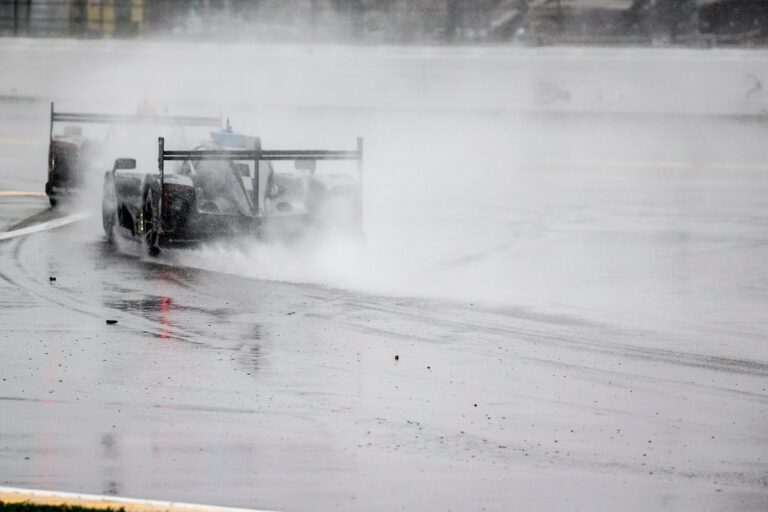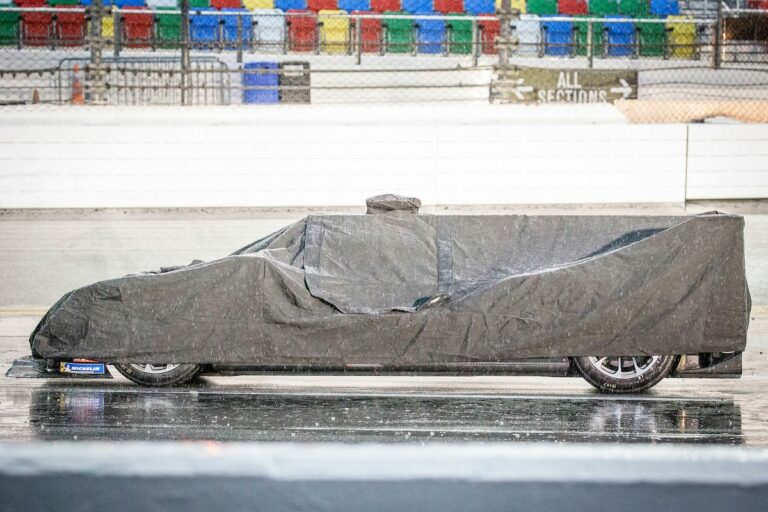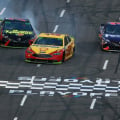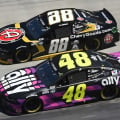IMSA officials explain the decisions made in rain shortened Rolex 24 at Daytona
The 2019 Rolex 24 at Daytona started out as a fantastic race. Wayne Taylor Racing, Whelen Engineering and the Mazda came were in a three way battle for the DPI and overall race lead at the front of the field.
That battle continued through most of the night. Around 5am, the race went sideways and shitty.
The skies opened and saturated the racing surface. It caused chaos on the race track. It was still entertaining during the moments of green flag action. But, it was entertaining for the wrong reasons.
The DPI leader hydroplaned through turn one. The car wouldn’t turn in the puddles and the lead was exchanged. The leader in GTD spun out.
Cars were getting rear-ended due to poor visibility in the braking zones. It was dangerous. It became less of a race and more of survival.
IMSA red flag the race in the early morning hours. The had several short stints of green that followed. Another red flag was dropped on the race in the final hours of the race.
The race never went green. The 24 Hours of Daytona was cut short and the race ended with covers on the race cars.

Mark Raffauf
“We have a very solid team in race control with very experienced people,” Mark Raffauf, IMSA Senior Director Racing Operations stated after the 2019 Rolex 24 at Daytona.
“Myself, I’ve done two other races here that were very similar. AJ Foyt’s win here in 1981 was very similar. It was virtually identical to this. 2004 was the same with about 23 hours of rain.”
“We obviously take safety into account, primarily. Competition secondarily. We made decisions today based on the information we had available to us on the condition of the track.”
“A lot of variables have to be taken into account from a lot of different variables. We chose to do what we did based in the information we had.”
“I feel very confident that we treated it well. The biggest problem at the speedway here is that once the ground is saturated it’s very difficult to remove it from the asphalt.”
Breaking points
“Once the cars can no longer technically compete, we feel it’s fairly senseless to carry on. Twice today, we made decisions to stop the race.”
“We tried every angle and every possibility that we had. Using all the hardware, people and staff that we have to do that. Unfortunately, we came up a little short.”
“The speedway unloaded the entire garage with everything we had. We had jets, vacuum trucks. We had buffalo sweepers, which are actually the most effective. Not necessarily for trying to dry the track but remove standing water.”
“There are places where there are puddles, no question about it. We tried to provide as little standing water on the surface as possible. The infield and bus stop, are flat. Those are the places where water will pool and also saturate the land adjacent to it.”
Repaving the Daytona road course?
“I cant speak for the speedway. But, the infield was last repaved in the early 2000’s.”
“I think over time, which the amount of use the facility gets, the aggregate of the surface becomes worn. It’s driven on a lot. So, certain parts of the track are slippery, even when dry.”
“I’m not an asphalt expert. But, it’s been 15 years.”
Other solutions?
Is there anything you could have done?
“Not really. We had pretty good indication that is was going to happen. We knew it was coming.”
“As it started building, it started coming in at 7/10th’s of an inch an hour. The track is not bad. But, visibility is another thing.”
“This was the first time on new Michelin rain tires. Rain tires tend to throw spray. That was a different experience for everybody I think.”
“Overall, we knew it was coming. But, there’s not a whole lot you can do about it,” Raffauf concluded.

Simon Hodgson
“We’re cognizant of the fact this is a special series cause it’s an endurance racing series. We race in a lot of differentiating conditions,” Simon Hodgson, IMSA Vice President of Competition stated.
“But, safety is priority. What level is perceived to be an appropriate risk? We’re doing all we can to take inputs from everybody. Sometimes, it appears those inputs might not be correct. Depending on where you are in the class position at the time.”
“In GTD, the class leader decided to pit. He went from being the class leader to the back of the class. The reality is, we don’t want to be driving the end result of the race.”
“We were looking to get the race in. It became very obvious, because of the way the weather was moving and increasing, it may be possible.”
“But, we also realized that we had to finish some of the race procedures. We didn’t want to enter a process where by… If we restarted under yellow, did those procedures and then ended. If at that time, after freezing the race, if somebody had gone off the track, it could have been the leader.”
“Then, we would have been sat here answering questions as to why we altered the outcome of the race,” Hodgson concluded.
More
Rolex 24 at Daytona results – January 27, 2019
The Rolex 24 was set to go green; Then, they dropped the red flag instead



